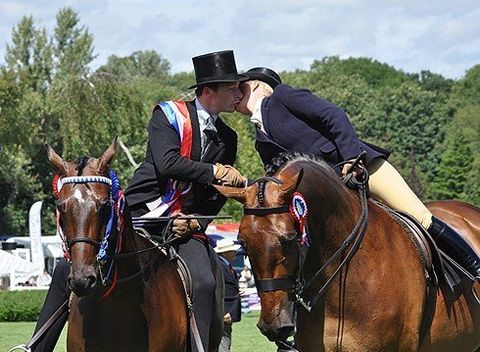The Royal International Horse ShowA Brief History
The first International Horse Show (minus the ‘Royal’ title) opened on June 7th 1907 at London’s Olympia. Its president was the Earl of Lonsdale (also famous in boxing circles) and vice presidents numbered 10 Dukes, 9 Marquises, 36 Earls, 14 Viscounts and 78 Lords. For the evening performance the audience wore full evening dress and there were traffic jams outside, albeit of horse drawn vehicles as the motor car was still a very expensive toy.
The show was an instant success and soon became an essential part of the London social scene. During those pre 1st World War years there were few classes under saddle with the hunters needing a certificate from an MFH that they had ‘hunted regularly’.
Jumping was not very popular but classes did include a high jump class and a wide jumping class. In 1911 a Russian element was introduced. ‘Trotters with Petrashka’ (galloping mate) to be driven in a wagon and another for troikas (3 abreast with the middle horse trotting while the others galloped).

The only interruption in the story of this wonderful show has been the 2 World Wars. Between the wars Bertram Mills was heavily involved and classes started to appear that have continued to this day. Hunters, hacks, cobs and ponies plus jumping became the mainstay of the show.
In 1947 the show was moved out of Central London to the now legendary White City Stadium and it was under new management from the newly formed British Horse Society. Thus, began an era for the show that many consider to be its pinnacle. With the BHS spearheading all equestrian activity in Britain the main disciplines were always well represented.
As our teams had great success in International competition including the Olympic Games so the popularity of equestrian events blossomed. Harry Llewellyn and the great Foxhunter was a regular
competitor.
In 1957 the show earned its ‘Royal’ prefix. It was during the 1960’s that show jumpers like David Broome, Harvey Smith and a host of others became household names as the BBC would broadcast live show jumping from this show at peek viewing time.
By the end of the 60’s finances were difficult and the venue was moved to the hallowed turf of Wembley Stadium, much to the fury of soccer fans, where it stayed for 2 years. It briefly returned to the White City before going to the National Exhibition Centre in Birmingham until 1991.
Douglas Bunn offered Hickstead as a home for the show and it opened there in 1992. These wonderful facilities enable a full range of showing and show jumping classes. This has enabled the show to reach the status it had a century ago, the pinnacle of achievement for many competitors but without full evening dress for the audience!

The BMHS Head Office, Stretcholt Farm, Bridgwater, TA6 4SR
| +44 (0)1278 685 943